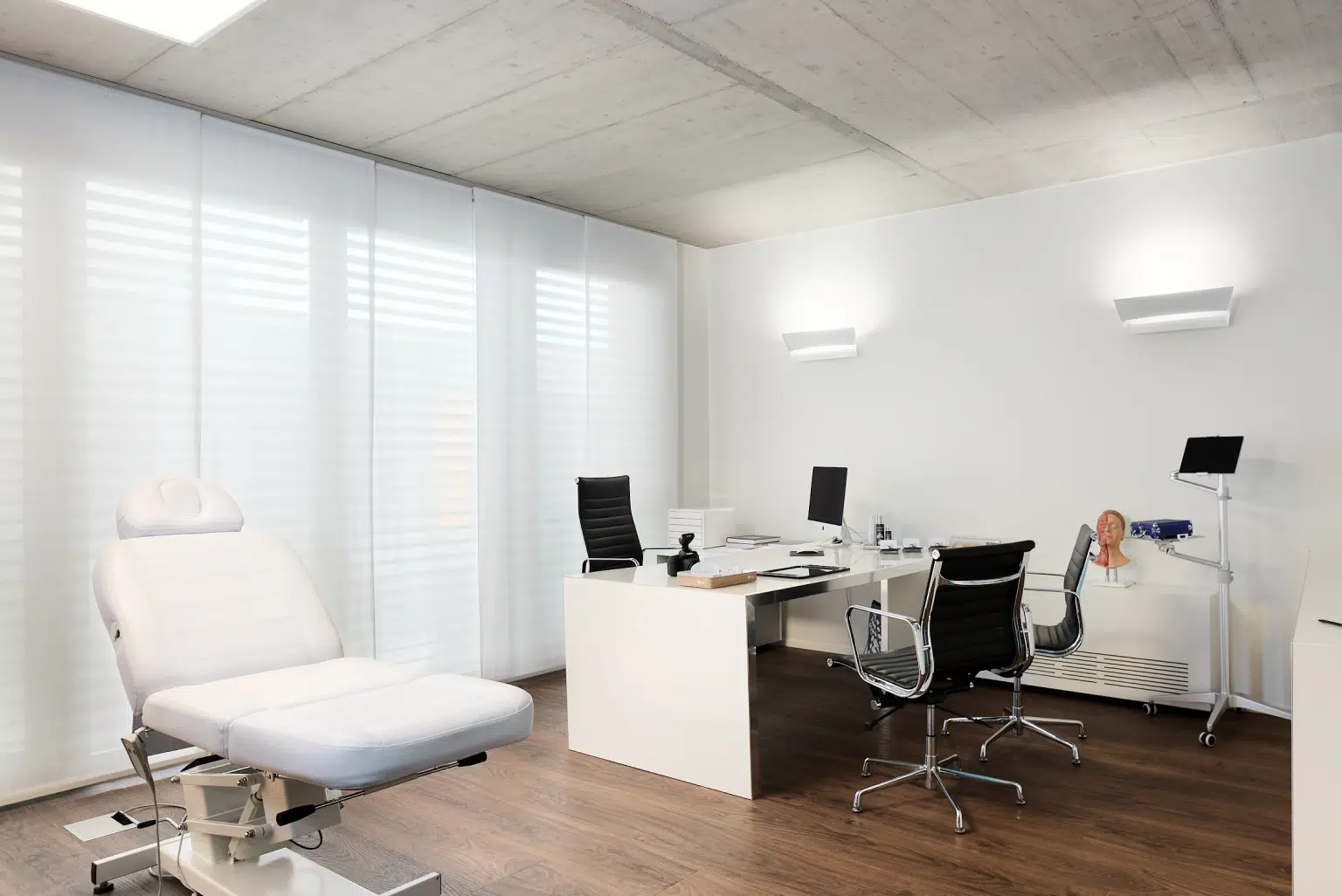Patient pathway
For a personalized and seamless experience, from the initial consultation to post-treatment follow-up, ensuring attentive care, expertise, and transparency at every step.

Types of anesthesia
General anesthesia
In this type of anesthesia, the patient is completely asleep, and breathing is controlled by the anesthesiologist. It is the preferred method for longer procedures, ensuring comfort for both patient and surgeon. Contrary to common belief, general anesthesia is one of the safest methods because the doctor maintains full control of the patient’s airway.
This type of anesthesia cannot be administered unless the patient has fasted for at least 6 hours. It is also contraindicated in cases of fever, colds, or uncontrolled illness.
Local anesthesia with sedation
This method combines local anesthesia with intravenously delivered sedation. It allows the patient to remain relaxed, pain-free, and without unpleasant memories of the procedure. This technique avoids intubation and side effects associated with general anesthesia, such as nausea. As with general anesthesia, fasting for at least 6 hours is required.
Local anesthesia
This is the preferred method for most of our treatments. Local anesthetic is injected into the treatment area to block pain sensation. It can be used to numb a specific zone (e.g., eyelids) or a specific nerve (e.g., a finger nerve). Given its low complication rate, local anesthesia is our standard choice for outpatient procedures, when appropriate. Fasting is not required. For anxious patients, we may offer an oral anti-anxiety medication.
General complications
As with any act in life, surgery carries risks and potential complications. Fortunately, these are rare in the hands of a certified surgeon, and most are temporary, reversible, or correctable. When the surgeon and patient work together, unwanted results are minimized.
It is the surgeon’s role to determine whether a patient is a suitable candidate for the desired procedure. Patients who follow medical advice and act responsibly greatly reduce the risk of complications. The most common general complications in plastic surgery include:
Unsightly scars
Any procedure involving a skin incision will leave a scar. Proper healing depends on five factors : the scar’s location, skin type, tension on the wound, wound care, and the patient’s overall health. Some body areas heal better than others; scars that follow natural folds and occur in thin skin are often nearly invisible. Some skin types (e.g., darker skin) are more prone to thick or keloid scars. Scars under high tension are more likely to widen. In adults, scars fully mature after 2 years; in children, it may take up to 5 years.
Hematomas and bruising
Bruising (or “blue marks”) is a normal effect that usually resolves within two weeks. A true hematoma is a collection of clotted blood that takes up space and is reabsorbed more slowly. Despite careful control of bleeding during surgery, hematomas can still occur in the first ten days post-op. To minimize risk, avoid blood-thinning medications (aspirin, Sintron, Plavix, NSAIDs), stress, strenuous efforts, and activities that increase blood pressure. In the case of a large hematoma, contact your surgeon immediately.
Seromas
Infections
Other potential effects
- Altered sensation
It is common to experience numbness around scars. This can last for several months and usually resolves completely.
- Wound separation and skin necrosis
Rarely, wounds may reopen or become irritated, forming scabs. This delays healing beyond the usual 10 days.
- Suture reaction
Some patients may react to sutures, particularly absorbable ones. This results in local inflammation, sometimes a small skin eruption, and eventual expulsion of the suture. It is not an infection and is easily managed.
- Asymmetry or suboptimal results
Surgery is both a science and an art, involving living tissues and not fine mechanical precision. A slight asymmetry is always possible, and most individuals naturally have asymmetries in their face or body. Most minor post-op asymmetries are well tolerated and do not require correction.
- Venous thrombosis
Long surgeries under general anesthesia increase the risk of blood clots in the leg veins, which is a serious complication. Preventative measures are always taken to reduce this risk.
Our team works diligently to minimize risks and complications. Dozens of procedures are safely performed each week without incident. However, every patient should be aware that any treatment involves risks. This is why understanding and accepting these risks is essential before undergoing any procedure.
Your doctor is your best source of information and will explain both general and personal risks related to your specific treatment.
Standard fees
The cost of cosmetic surgery depends on five main factors :
- Type of anesthesia used
- Whether an overnight clinic stay is required
- Surgical time
- Use of special products (e.g., implants)
- Technical complexity of the procedure
Because of this, it’s difficult to provide accurate estimates without a consultation. At the end of your first appointment, you will receive a detailed and personalized quote.
Some standard procedures are offered at a flat rate, which covers the entire care package.
Installment payments
We understand that treatments can be costly, which is why we have partnered with a Swiss financial institution to offer flexible payment plans to our patients.
At Leman Aesthetic Clinic, we are committed to ensuring that every patient has access to the highest level of care. Your well-being is our top priority.